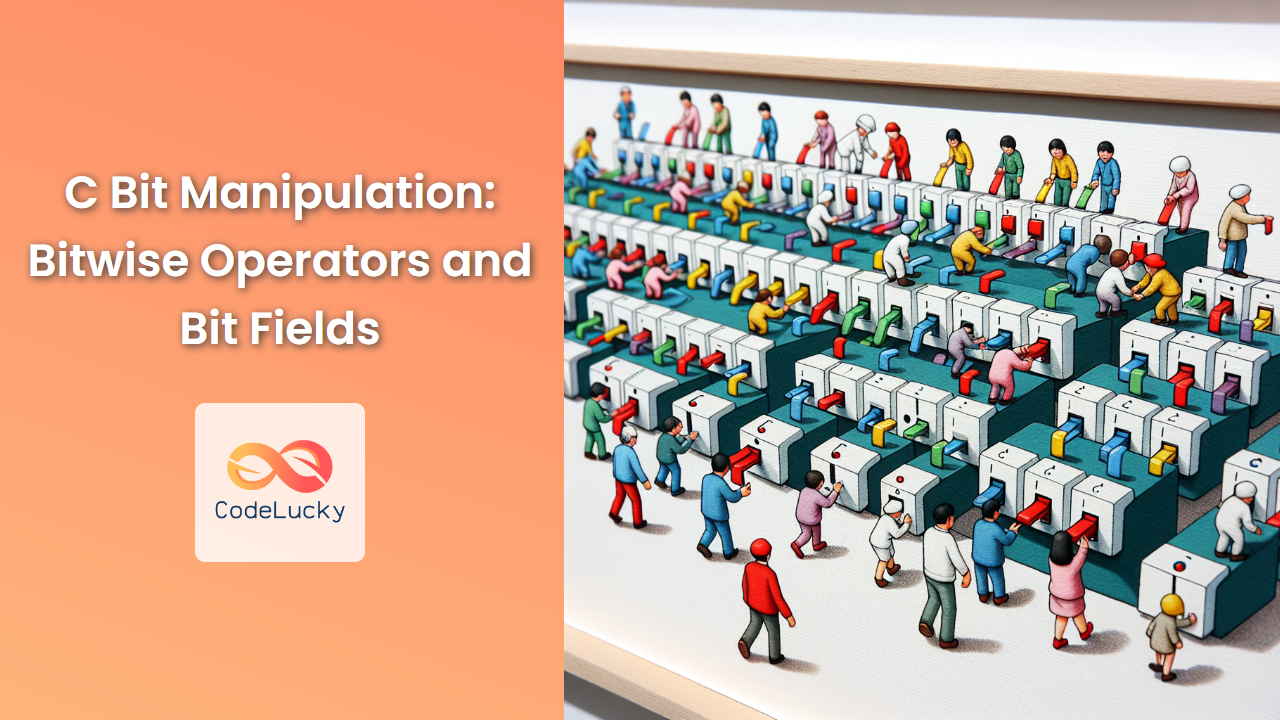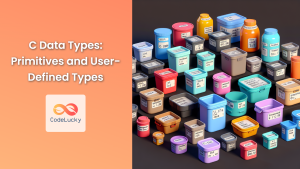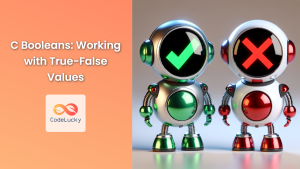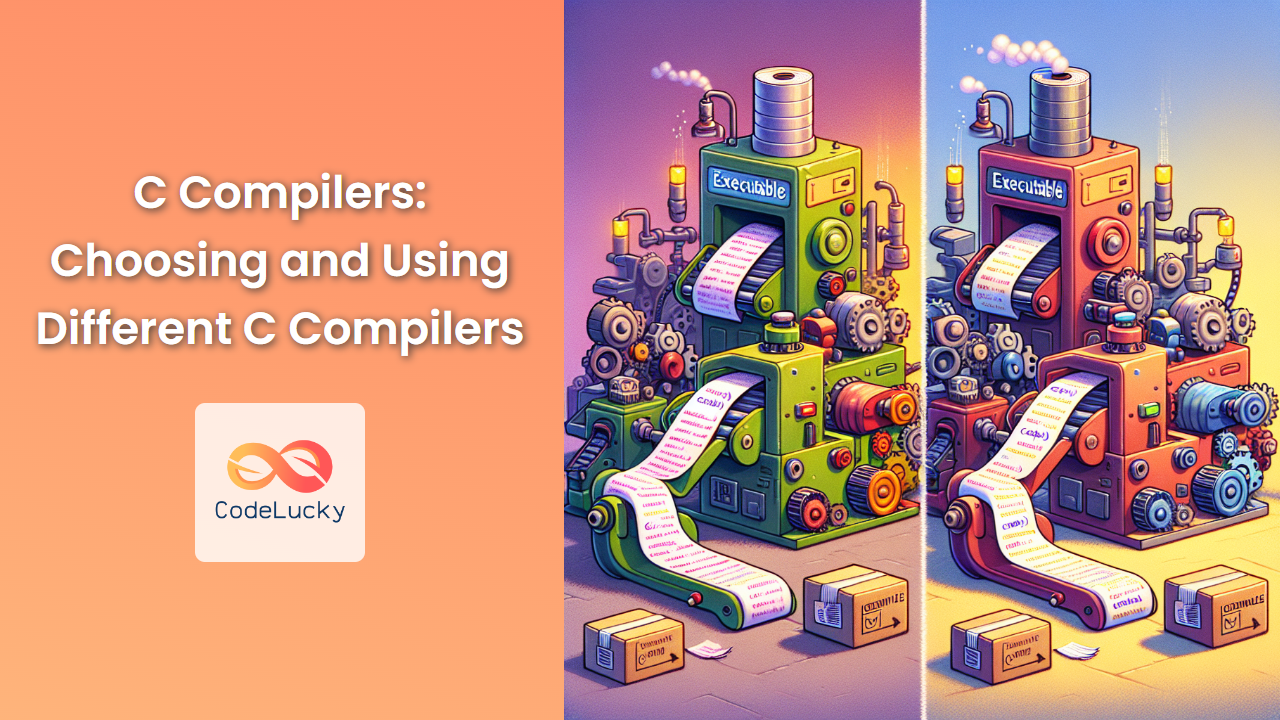In the world of C programming, bit manipulation is a powerful technique that allows developers to work directly with individual bits within data. This low-level control is essential for various applications, from embedded systems to network protocols. In this comprehensive guide, we'll dive deep into the realm of bitwise operators and bit fields in C, exploring their syntax, use cases, and best practices.
Bitwise Operators in C
C provides six bitwise operators that allow you to manipulate individual bits within integer types. Let's explore each of these operators in detail:
1. Bitwise AND (&)
The bitwise AND operator compares each bit of two operands and returns 1 if both bits are 1, otherwise 0.
#include <stdio.h>
int main() {
unsigned char a = 0b11001100; // 204 in decimal
unsigned char b = 0b10101010; // 170 in decimal
unsigned char result = a & b;
printf("a: %d (0b%08b)\n", a, a);
printf("b: %d (0b%08b)\n", b, b);
printf("result: %d (0b%08b)\n", result, result);
return 0;
}
Output:
a: 204 (0b11001100)
b: 170 (0b10101010)
result: 136 (0b10001000)
In this example, we perform a bitwise AND operation on two 8-bit values. The result shows that only the bits that are 1 in both operands remain 1 in the result.
2. Bitwise OR (|)
The bitwise OR operator compares each bit of two operands and returns 1 if at least one of the bits is 1, otherwise 0.
#include <stdio.h>
int main() {
unsigned char a = 0b11001100; // 204 in decimal
unsigned char b = 0b10101010; // 170 in decimal
unsigned char result = a | b;
printf("a: %d (0b%08b)\n", a, a);
printf("b: %d (0b%08b)\n", b, b);
printf("result: %d (0b%08b)\n", result, result);
return 0;
}
Output:
a: 204 (0b11001100)
b: 170 (0b10101010)
result: 238 (0b11101110)
Here, we see that the result contains a 1 wherever either operand has a 1.
3. Bitwise XOR (^)
The bitwise XOR (exclusive OR) operator compares each bit of two operands and returns 1 if the bits are different, otherwise 0.
#include <stdio.h>
int main() {
unsigned char a = 0b11001100; // 204 in decimal
unsigned char b = 0b10101010; // 170 in decimal
unsigned char result = a ^ b;
printf("a: %d (0b%08b)\n", a, a);
printf("b: %d (0b%08b)\n", b, b);
printf("result: %d (0b%08b)\n", result, result);
return 0;
}
Output:
a: 204 (0b11001100)
b: 170 (0b10101010)
result: 102 (0b01100110)
The XOR operation results in a 1 only where the bits in the operands differ.
4. Bitwise NOT (~)
The bitwise NOT operator inverts all the bits of its operand.
#include <stdio.h>
int main() {
unsigned char a = 0b11001100; // 204 in decimal
unsigned char result = ~a;
printf("a: %d (0b%08b)\n", a, a);
printf("result: %d (0b%08b)\n", result, result);
return 0;
}
Output:
a: 204 (0b11001100)
result: 51 (0b00110011)
Notice how every 1 becomes a 0 and vice versa in the result.
5. Left Shift (<<)
The left shift operator moves all bits in a value to the left by a specified number of positions.
#include <stdio.h>
int main() {
unsigned char a = 0b00001111; // 15 in decimal
unsigned char result = a << 2;
printf("a: %d (0b%08b)\n", a, a);
printf("result: %d (0b%08b)\n", result, result);
return 0;
}
Output:
a: 15 (0b00001111)
result: 60 (0b00111100)
In this example, all bits are shifted 2 positions to the left, and 0s are filled in from the right.
6. Right Shift (>>)
The right shift operator moves all bits in a value to the right by a specified number of positions.
#include <stdio.h>
int main() {
unsigned char a = 0b11110000; // 240 in decimal
unsigned char result = a >> 2;
printf("a: %d (0b%08b)\n", a, a);
printf("result: %d (0b%08b)\n", result, result);
return 0;
}
Output:
a: 240 (0b11110000)
result: 60 (0b00111100)
Here, all bits are shifted 2 positions to the right, and 0s are filled in from the left (for unsigned types).
Practical Applications of Bitwise Operators
Now that we've covered the basics, let's explore some practical applications of bitwise operators in C programming.
1. Setting a Bit
To set a specific bit in a number, we can use the bitwise OR operator with a mask.
#include <stdio.h>
unsigned char setBit(unsigned char num, int position) {
return num | (1 << position);
}
int main() {
unsigned char a = 0b10101010; // 170 in decimal
int bitPosition = 2;
unsigned char result = setBit(a, bitPosition);
printf("Original: %d (0b%08b)\n", a, a);
printf("Modified: %d (0b%08b)\n", result, result);
return 0;
}
Output:
Original: 170 (0b10101010)
Modified: 174 (0b10101110)
In this example, we set the bit at position 2 (counting from 0 from the right) to 1.
2. Clearing a Bit
To clear a specific bit in a number, we can use the bitwise AND operator with an inverted mask.
#include <stdio.h>
unsigned char clearBit(unsigned char num, int position) {
return num & ~(1 << position);
}
int main() {
unsigned char a = 0b10101110; // 174 in decimal
int bitPosition = 2;
unsigned char result = clearBit(a, bitPosition);
printf("Original: %d (0b%08b)\n", a, a);
printf("Modified: %d (0b%08b)\n", result, result);
return 0;
}
Output:
Original: 174 (0b10101110)
Modified: 170 (0b10101010)
Here, we clear the bit at position 2, setting it to 0.
3. Toggling a Bit
To toggle (flip) a specific bit in a number, we can use the bitwise XOR operator with a mask.
#include <stdio.h>
unsigned char toggleBit(unsigned char num, int position) {
return num ^ (1 << position);
}
int main() {
unsigned char a = 0b10101010; // 170 in decimal
int bitPosition = 3;
unsigned char result = toggleBit(a, bitPosition);
printf("Original: %d (0b%08b)\n", a, a);
printf("Modified: %d (0b%08b)\n", result, result);
return 0;
}
Output:
Original: 170 (0b10101010)
Modified: 162 (0b10100010)
In this example, we toggle the bit at position 3, changing it from 1 to 0.
4. Checking if a Bit is Set
To check if a specific bit is set (1) in a number, we can use the bitwise AND operator with a mask.
#include <stdio.h>
#include <stdbool.h>
bool isBitSet(unsigned char num, int position) {
return (num & (1 << position)) != 0;
}
int main() {
unsigned char a = 0b10101010; // 170 in decimal
int bitPosition = 1;
bool result = isBitSet(a, bitPosition);
printf("Number: %d (0b%08b)\n", a, a);
printf("Is bit %d set? %s\n", bitPosition, result ? "Yes" : "No");
return 0;
}
Output:
Number: 170 (0b10101010)
Is bit 1 set? Yes
This function checks if the bit at position 1 is set, which it is in this case.
5. Counting Set Bits
To count the number of set bits (1s) in a number, we can use a combination of bitwise AND and right shift operations.
#include <stdio.h>
int countSetBits(unsigned char num) {
int count = 0;
while (num) {
count += num & 1;
num >>= 1;
}
return count;
}
int main() {
unsigned char a = 0b10101010; // 170 in decimal
int result = countSetBits(a);
printf("Number: %d (0b%08b)\n", a, a);
printf("Number of set bits: %d\n", result);
return 0;
}
Output:
Number: 170 (0b10101010)
Number of set bits: 4
This function efficiently counts the number of set bits in the given number.
Bit Fields in C
Bit fields are a feature in C that allows you to specify the number of bits a member of a structure should occupy. This is particularly useful when you need to conserve memory or when working with hardware that uses specific bit patterns.
Syntax and Usage
Here's an example of how to define and use bit fields:
#include <stdio.h>
struct PackedData {
unsigned int flag1 : 1;
unsigned int flag2 : 1;
unsigned int flag3 : 1;
unsigned int count : 5;
};
int main() {
struct PackedData data = {1, 0, 1, 15};
printf("Size of PackedData: %zu bytes\n", sizeof(struct PackedData));
printf("flag1: %d\n", data.flag1);
printf("flag2: %d\n", data.flag2);
printf("flag3: %d\n", data.flag3);
printf("count: %d\n", data.count);
return 0;
}
Output:
Size of PackedData: 4 bytes
flag1: 1
flag2: 0
flag3: 1
count: 15
In this example, we define a structure PackedData with four bit fields:
- Three 1-bit fields for flags
- One 5-bit field for a count (can store values from 0 to 31)
The total size of the structure is 4 bytes (32 bits) because the compiler typically aligns bit fields to the nearest word boundary.
Advantages of Bit Fields
- Memory Efficiency: Bit fields allow you to pack multiple values into a single word, saving memory.
- Hardware Compatibility: They're useful when working with hardware registers that have specific bit patterns.
- Readability: Bit fields can make code more readable by giving meaningful names to individual bits or groups of bits.
Limitations of Bit Fields
- Portability: The exact layout of bit fields can vary between compilers and platforms.
- Limited Operations: You can't take the address of a bit field or use array indexing with them.
- Performance: Accessing bit fields can be slower than accessing full-sized integers due to the extra bit manipulation required.
Advanced Bit Manipulation Techniques
Let's explore some more advanced bit manipulation techniques that can be incredibly useful in certain scenarios.
1. Swapping Values Without a Temporary Variable
We can use the XOR operation to swap two values without using a temporary variable:
#include <stdio.h>
void swapWithXOR(int *a, int *b) {
*a = *a ^ *b;
*b = *a ^ *b;
*a = *a ^ *b;
}
int main() {
int x = 10, y = 20;
printf("Before swap: x = %d, y = %d\n", x, y);
swapWithXOR(&x, &y);
printf("After swap: x = %d, y = %d\n", x, y);
return 0;
}
Output:
Before swap: x = 10, y = 20
After swap: x = 20, y = 10
This technique works because of the properties of XOR: (A^B)^B = A and A^(A^B) = B.
2. Finding the Rightmost Set Bit
To find the position of the rightmost set bit in a number, we can use a combination of bitwise operations:
#include <stdio.h>
int findRightmostSetBit(int n) {
return n & -n;
}
int main() {
int num = 0b10100000; // 160 in decimal
int result = findRightmostSetBit(num);
printf("Number: %d (0b%08b)\n", num, num);
printf("Rightmost set bit: %d (0b%08b)\n", result, result);
return 0;
}
Output:
Number: 160 (0b10100000)
Rightmost set bit: 32 (0b00100000)
This technique works because -n is the two's complement of n, which flips all bits after the rightmost set bit.
3. Checking if a Number is a Power of 2
We can use bitwise operations to efficiently check if a number is a power of 2:
#include <stdio.h>
#include <stdbool.h>
bool isPowerOfTwo(int n) {
return n > 0 && (n & (n - 1)) == 0;
}
int main() {
int numbers[] = {1, 2, 4, 7, 8, 15, 16, 32};
int size = sizeof(numbers) / sizeof(numbers[0]);
for (int i = 0; i < size; i++) {
printf("%d is %sa power of 2\n", numbers[i], isPowerOfTwo(numbers[i]) ? "" : "not ");
}
return 0;
}
Output:
1 is a power of 2
2 is a power of 2
4 is a power of 2
7 is not a power of 2
8 is a power of 2
15 is not a power of 2
16 is a power of 2
32 is a power of 2
This works because a power of 2 has only one bit set, and subtracting 1 from it will set all lower bits to 1.
4. Calculating the Absolute Value
We can use bitwise operations to calculate the absolute value of an integer efficiently:
#include <stdio.h>
int absoluteValue(int n) {
int mask = n >> (sizeof(int) * 8 - 1);
return (n + mask) ^ mask;
}
int main() {
int numbers[] = {-5, 0, 3, -12, 8};
int size = sizeof(numbers) / sizeof(numbers[0]);
for (int i = 0; i < size; i++) {
printf("Absolute value of %d is %d\n", numbers[i], absoluteValue(numbers[i]));
}
return 0;
}
Output:
Absolute value of -5 is 5
Absolute value of 0 is 0
Absolute value of 3 is 3
Absolute value of -12 is 12
Absolute value of 8 is 8
This technique works by creating a mask of all 1s for negative numbers and all 0s for non-negative numbers, then using XOR to flip the bits if necessary.
Best Practices and Considerations
When working with bitwise operations and bit fields in C, keep these best practices in mind:
-
Use Unsigned Types: When possible, use unsigned integer types for bitwise operations to avoid unexpected behavior with sign bits.
-
Be Careful with Shift Amounts: Shifting by a negative amount or by an amount greater than or equal to the width of the type is undefined behavior in C.
-
Use Parentheses: Always use parentheses to ensure the correct order of operations, especially when combining bitwise and arithmetic operations.
-
Consider Portability: Be aware that bit field layouts can vary between compilers and platforms. If portability is a concern, consider using bitwise operations instead.
-
Document Bit Meanings: When using bit fields or bit flags, clearly document what each bit represents to improve code readability and maintainability.
-
Use Named Constants: Instead of using magic numbers for bit positions or masks, define named constants to make your code more readable and easier to maintain.
-
Be Mindful of Performance: While bitwise operations are generally fast, complex bit manipulations can sometimes be slower than equivalent arithmetic operations. Profile your code if performance is critical.
-
Test Thoroughly: Bit manipulation errors can be subtle. Write comprehensive unit tests to ensure your bitwise operations behave as expected.
Conclusion
Bit manipulation and bit fields are powerful tools in a C programmer's arsenal. They allow for efficient memory usage, fast operations, and direct hardware interaction. By mastering these techniques, you can write more efficient and elegant code, especially in domains like embedded systems, network protocols, and low-level system programming.
Remember that while these techniques can lead to very efficient code, they can also make code harder to read and maintain if not used judiciously. Always strive for a balance between efficiency and readability, and document your bit-level operations clearly.
As you continue to explore C programming, experiment with these bitwise techniques and discover how they can be applied to solve real-world problems efficiently. Happy coding!

















